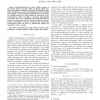Free Online Productivity Tools
i2Speak
i2Symbol
i2OCR
iTex2Img
iWeb2Print
iWeb2Shot
i2Type
iPdf2Split
iPdf2Merge
i2Bopomofo
i2Arabic
i2Style
i2Image
i2PDF
iLatex2Rtf
Sci2ools
CORR
2010
Springer
2010
Springer
Techniques for Enhanced Physical-Layer Security
Information-theoretic security--widely accepted as the strictest notion of security--relies on channel coding techniques that exploit the inherent randomness of propagation channels to strengthen the security of communications systems. Within this paradigm, we explore strategies to improve secure connectivity in a wireless network. We first consider the intrinsically secure communications graph (iS-graph), a convenient representation of the links that can be established with information-theoretic security on a large-scale network. We then propose and characterize two techniques--sectorized transmission and eavesdropper neutralization--which are shown to dramatically enhance the connectivity of the iS-graph.
| Added | 09 Dec 2010 |
| Updated | 09 Dec 2010 |
| Type | Journal |
| Year | 2010 |
| Where | CORR |
| Authors | Pedro C. Pinto, João Barros, Moe Z. Win |
Comments (0)

